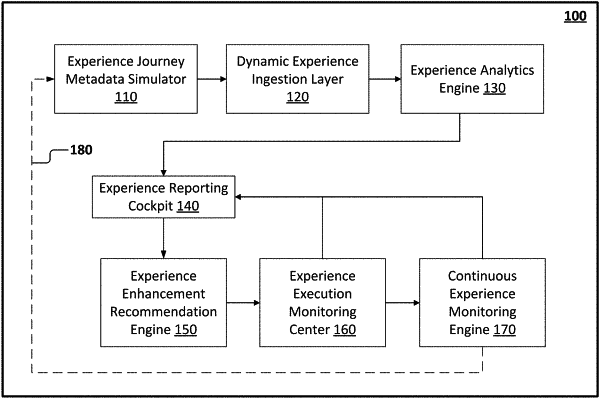| CPC G06F 16/951 (2019.01) [G06F 16/9535 (2019.01); G06F 16/9537 (2019.01); G06F 16/9538 (2019.01); G06N 20/00 (2019.01)] | 20 Claims |

|
1. A system to assess user experience, comprising:
one or more computers and one or more storage devices storing instructions thereon that, when executed by the one or more computers, cause the one or more computers to form one or more functional modules comprising:
an experience journey metadata simulator configured to determine one or more experience journey maps and identify personas who participate in the one or more experience journey maps, wherein each of the one or more journey maps comprises one or more processes performed by the identified personas;
a dynamic experience ingestion layer configured to collect user experience related data from the participating personas, one or more system logs, or combinations thereof, wherein the user experience related data comprise text data, audio data, video data, or combinations thereof collected via corresponding extractor engines operable to collect, parse, and extract user experience related metrics from the collected user experience related data;
an experience analytics engine configured to identify user experience gaps, as perceived by the personas, by processing and classifying with one or more computer-implemented models the user experience related metrics outputted by the extractor engines in the dynamic experience ingestion layer, wherein the user experience gaps correspond to user experience differences between personas acting as customers and personas acting as employees, and wherein the user experience gaps are quantified, measured, and classified in terms of a four dimension matrix;
an experience reporting cockpit configured to (i) provide a graphical representation that highlights the user experience gaps identified by the experience analytics engine and (ii) perform root cause analysis for the identified user experience gaps by defining potential factors for each user experience gap, and subsequently aggregating and accumulating the user experience gaps under the defined factors;
an experience enhancement recommendation engine configured to auto-generate recommendations for execution to mitigate the user experience gaps highlighted in the graphical representation, wherein the auto-generated recommendations include recommendation proposal data categorized based on the root cause analysis performed in the experience reporting cockpit;
an experience execution monitoring center configured to monitor and track a progress of the executed recommendations, detect whether potential corrective actions are required, and provide feedback about the progress and the potential corrective actions to the experience reporting cockpit; and
a continuous experience monitoring engine configured to:
perform automated monitoring and offset metric tracking of targeted experience-related input metrics used to gauge a performance of the executed recommendations; and
report the performance of the executed recommendations to the experience reporting cockpit so that new recommendations are autogenerated by the experience enhancement recommendation engine when the performance is moving towards a non-desirable direction.
|